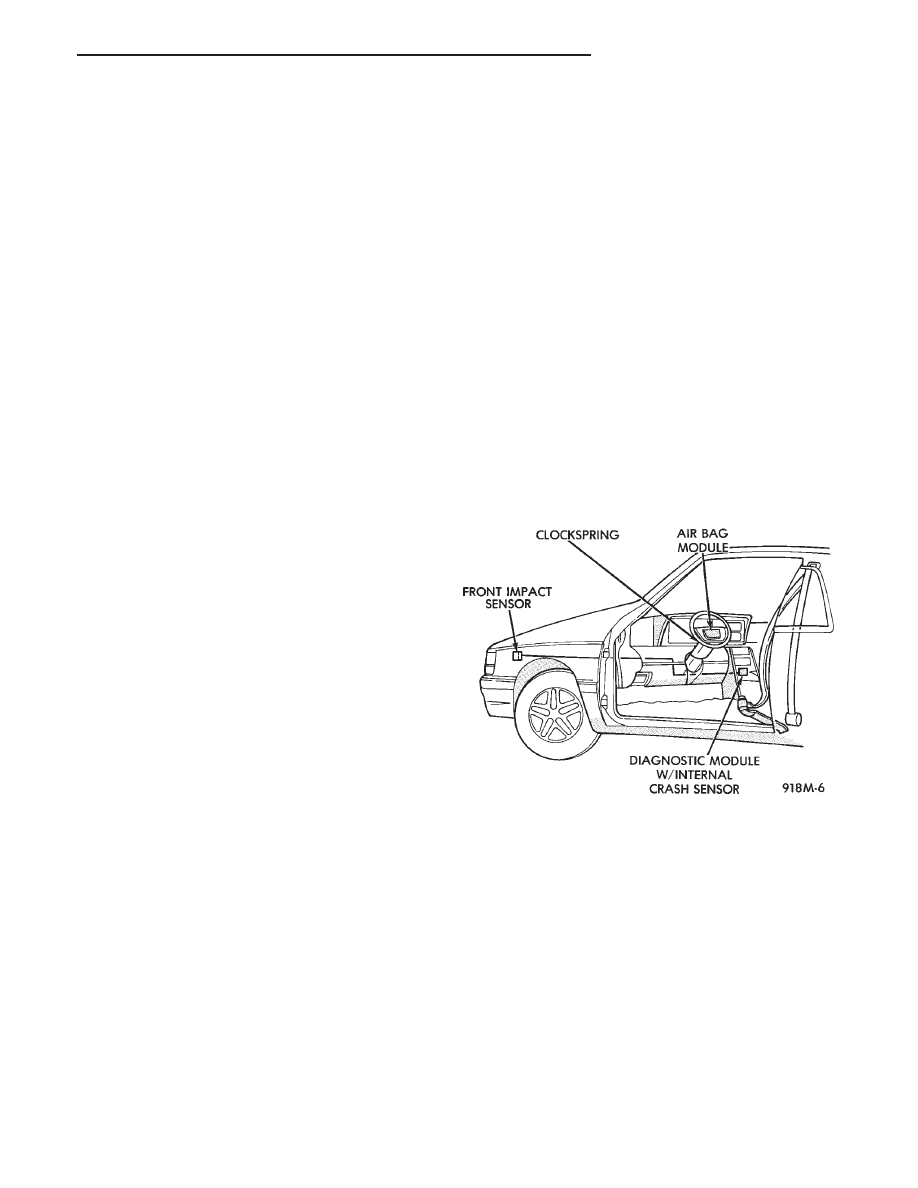Chrysler Town & Country/Voyager, Dodge Caravan, Plymouth Voyager. Manual - part 226

RESTRAINT SYSTEMS
CONTENTS
page
page
AIR BAG MODULE
. . . . . . . . . . . . . . . . . . . . . . . 3
AIR BAG SERVICE AND TEST PROCEDURES
. . 1
AIR BAG SYSTEM CHECK
. . . . . . . . . . . . . . . . . 3
AIR BAG SYSTEM DIAGNOSTIC
MODULE (ASDM)
. . . . . . . . . . . . . . . . . . . . . . 5
CLOCKSPRING
. . . . . . . . . . . . . . . . . . . . . . . . . . 5
CLOCKSPRING CENTERING PROCEDURE
. . . . . 6
GENERAL INFORMATION
. . . . . . . . . . . . . . . . . . 1
LEFT FRONT IMPACT SENSOR
. . . . . . . . . . . . . 4
RIGHT FRONT IMPACT SENSOR
. . . . . . . . . . . . 4
STEERING COLUMN SWITCHES
. . . . . . . . . . . . 7
STEERING WHEEL
. . . . . . . . . . . . . . . . . . . . . . . 7
AIR BAG SERVICE AND TEST PROCEDURES
WARNING: THIS SYSTEM IS A SENSITIVE, COMPLEX
ELECTRO-MECHANICAL UNIT. BEFORE ATTEMPT-
ING TO DIAGNOSE, REMOVE OR INSTALL THE AIR
BAG SYSTEM COMPONENTS, YOU MUST FIRST DIS-
CONNECT AND ISOLATE THE NEGATIVE (GROUND)
BATTERY CABLE. FAILURE TO DO SO COULD RE-
SULT IN ACCIDENTAL DEPLOYMENT AND POSSIBLE
PERSONAL INJURY.
WHEN AN UNDEPLOYED AIR BAG ASSEMBLY IS
TO BE REMOVED FROM THE STEERING WHEEL,
DISCONNECT BATTERY GROUND CABLE AND
ISOLATE. ALLOW SYSTEM CAPACITOR TO DIS-
CHARGE FOR TWO MINUTES THEN BEGIN AIR
BAG SYSTEM COMPONENT REMOVAL.
Vehicles equipped with a Minivan Driver Air Bag
System must be inspected every 3 years or 30,000
miles / 48,000 Km. To inspect system use Passive
Restraint System Diagnostic Procedures Manual.
If the Air Bag Module Assembly is defective and
non-deployed, refer to Chrysler Motors current return
list for proper handling procedures.
WARNING: REPLACE AIR BAG SYSTEM COMPO-
NENTS WITH CHRYSLER MOPAR
T
SPECIFIED RE-
PLACEMENT PARTS. SUBSTITUTE PARTS MAY VI-
SUALLY
APPEAR
INTERCHANGEABLE,
BUT
INTERNAL DIFFERENCES MAY RESULT IN INFERIOR
OCCUPANT PROTECTION.
THE FASTENERS, SCREWS, AND BOLTS, ORIGI-
NALLY USED FOR THE AIR BAG COMPONENTS,
HAVE SPECIAL COATINGS AND ARE SPECIFI-
CALLY DESIGNED FOR THE AIR BAG SYSTEM.
THEY MUST NEVER BE REPLACED WITH ANY
SUBSTITUTES. ANYTIME A NEW FASTENER IS
NEEDED, REPLACE WITH THE CORRECT FAS-
TENERS PROVIDED IN THE SERVICE PACKAGE
OR FASTENERS LISTED IN THE PARTS BOOKS.
GENERAL INFORMATION
AIR BAG MODULE
The air bag module is the most visible part of the
system (Fig 1). It contains the air bag cushion and its
supporting components. The air bag module contains a
housing to which the cushion and inflator are attached
and sealed.
The inflator assembly is mounted to the back of the
module housing. When supplied with the proper elec-
trical signal the inflator assembly will produce a gas
and discharges it directly into the cushion. A protective
cover is fitted to the front of the air bag module and
forms a decorative cover in the center of the steering
wheel. The air bag module is mounted directly to the
steering wheel.
FRONT IMPACT SENSORS
The driver air bag system is a safety device designed
to deduce the risk of fatality or serious injury, caused
by a frontal impact of the vehicle.
The impact sensors provide verification of the
direction and severity of the impact. Three impact
sensors are used. One is called a safing sensor. It
is located inside the diagnostic module which is
Fig. 1 Minivan Driver Air Bag System
.
RESTRAINT SYSTEMS
8M - 1